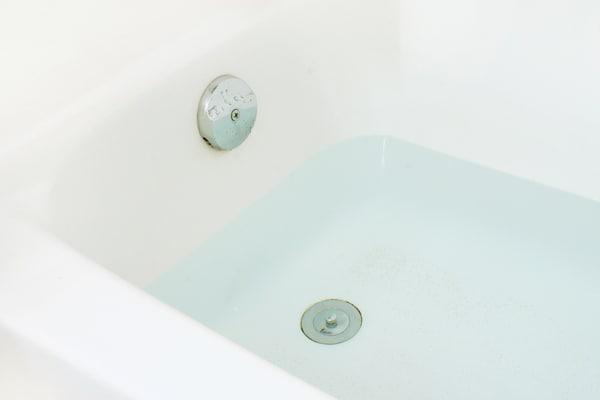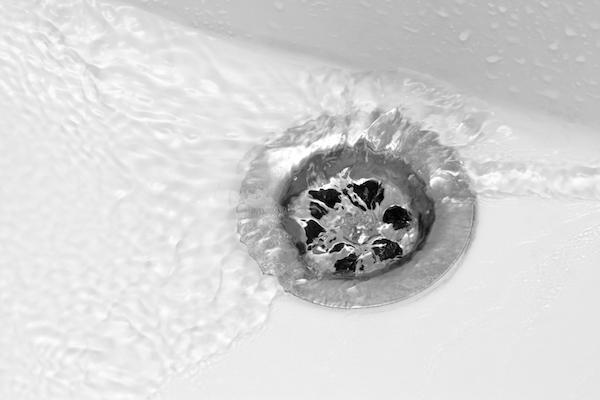Is My Bathtub Drain Leaking?
August 30, 2020

Plumbing leaks can be destructive and expensive. Catching the problem sooner rather than later could mean the difference between a simple trip to the hardware store vs. tearing out your wall. Bubbles, peeling paint, or damp spots on the wall are sure signs you have a tub leak.
Identifying the source of the problem may prove tricky depending on what kind of bathtub you have. Fixing the problem may be even trickier if the pipes in question aren’t easily accessible. We’ll walk you through the ins and outs of bathtub leaks. You can decide whether to plunge in or leave it to the professionals.
How to Tell if You Have A Bathtub Drain Leak
It’s possible for a bathtub leak to become so bad that the ceiling beneath fills with water and bows out like giant plaster zits waiting to burst. Assuming the problem isn’t quite this obvious, let’s look at other signs of bathtub drain leaks. Keep in mind some leaks develop slowly and go undetected for some time. Here’s where to start:
Is the Leak in the Tub or in the Plumbing?

The first step in narrowing down the problem is to test whether the leak is outside or inside the drain. Fill up your tub with a measurable amount of water. Check it after an hour to determine if the water level has gone down. If it has, the leak is happening before the water drains. It may be your drain plug or drain seal.
If the water level remains constant, then your leak is somewhere along the drain’s path.
Do you have a Freestanding Tub or an Alcove Tub?
If your tub is freestanding or claw foot tub, you’ll be able to see a portion of the plumbing from the bottom of the tub to the floor or wall. Inspect these pipes for signs of moisture. Placing newspaper beneath them is an easy way to identify signs of dripping water.
If you have an alcove tub, the plumbing is usually recessed and out of sight. In that case, examining the walls and floors for signs of moisture and rot will be the easiest first step to identifying a leak. Check for:
- Peeling paint
- Soft wood
- Damaged plaster
- Loose tiles
- Curled vinyl flooring
- Spotting
If you notice any of these signs, chances are you have a drain leak. A call to your trusted plumber can help you pinpoint the source.
Why is My Bathtub Drain Leaking?
There are many factors that contribute to a leaking tub drain. The age and type of plumbing may be the simplest response. A more detailed explanation could involve one or more of these reasons:
- Faulty seals. Age, moisture, and use can erode the seals around drains or connecting pipes.
- Clogged pipes. Old pipes collect grease and hair. As clogs build up, the pressure changes and causes the water to find alternate routes to escape.
- Rust or corrosion. Old pipes deteriorate. As they age, their ability to move water becomes compromised from both inside and outside.
- Temperature changes. Shifts in temperatures cause pipes to expand and contract, causing seals and connections to loosen.
No matter what the cause, leaking drains and pipes should be repaired quickly after diagnosis.
Why Are Leaky Drains Such a Problem?
Water damage is a serious issue that can impact your home and health. Leaks that go undetected can damage walls or flooring in your home. Depending on the level of damage, you may even need to replace ruined plaster, tile, and wood.
More significantly, moisture in your home can promote the growth of mildew and mold. These can fester, unnoticed, within your walls or flooring, until serious health issues develop. If you develop any of the following symptoms, they could be mold related:
- Coughing
- Sneezing or stuffy nose
- Itching in your eyes, nose, or throat
- Watery eyes
- Dry skin
People with allergies or asthma are more susceptible to the effects of mold.
How Do I Fix A Leaky Bathtub Drain?
Depending on the severity of your leak, repair may be straightforward or may require extensive work. If the leak is in the drain itself, you may be able to simply unscrew the drain from the bathtub and reseal it with plumber’s putty or a new gasket.
If pipes show damage, however, you’ll probably need to replace a portion of the plumbing and even parts of the walls or flooring. Re-caulking tile will also help to prevent future moisture-related damage.
Your Local Leak Repair Experts in Dallas
Bathtub leaks may seem like a small issue, and hopefully yours is, but if you need help locating or repairing a leak, a good plumber makes all the difference. The experts at Ben Franklin can help diagnose and repair your bathtub leak before it wreaks havoc on your home or health. Just give us a call the moment you notice–or even just think you notice–a leak.